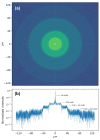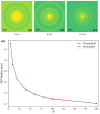Simulation of Fresnel Zone Plate Imaging Performance with Number of Zones
- PMID: 33233576
- PMCID: PMC7699809
- DOI: 10.3390/s20226649
Simulation of Fresnel Zone Plate Imaging Performance with Number of Zones
Abstract
In recent years, integral imaging, a promising three-dimensional imaging technology, has attracted more and more attention for its broad applications in robotics, computational vision, and medical diagnostics. In the visible spectrum, an integral imaging system can be easily implemented by inserting a micro-lens array between a image formation optic and a pixelated detector. By using a micro-Fresnel Zone Plate (FZP) array instead of the refractive lens array, the integral imaging system can be applied in X-ray. Due to micro-scale dimensions of FZP in the array and current manufacturing techniques, the number of zones of FZP is limited. This may have an important impact on the FZP imaging performance. The paper introduces a simulation method based on the scalar diffraction theory. With the aid of this method, the effect of the number of zones on the FZP imaging performance is numerically investigated, especially the case of very small number of zones. Results of several simulation of FZP imaging are presented and show the image can be formed by a FZP with a number of zones as low as 5. The paper aims at offering a numerical approach in order to facilitate the design of FZP for integral imaging.
Keywords: X-ray integral imaging; fresnel zone plate; modeling; wave propagator.
Conflict of interest statement
The authors declare no conflict of interest.
Figures









References
-
- Lippmann G. Epreuves reversibles donnant la sensation du relief. J. Phys. Theor. Appl. 1908;7:821–825. doi: 10.1051/jphystap:019080070082100. - DOI
-
- Ng R., Levoy M., Brédif M., Duval G., Horowitz M., Hanrahan P. Ph.D. Thesis. Stanford University; Stanford, CA, USA: 2005. [(accessed on 19 November 2020)]. Light Field Photography with a Hand-Held Plenoptic Camera. Available online: https://hal.archives-ouvertes.fr/hal-02551481.
-
- Tian L., Waller L. 3D intensity and phase imaging from light field measurements in an LED array microscope. Optica. 2015;2:104–111. doi: 10.1364/OPTICA.2.000104. - DOI
Publication types
Grants and funding
LinkOut - more resources
Full Text Sources

